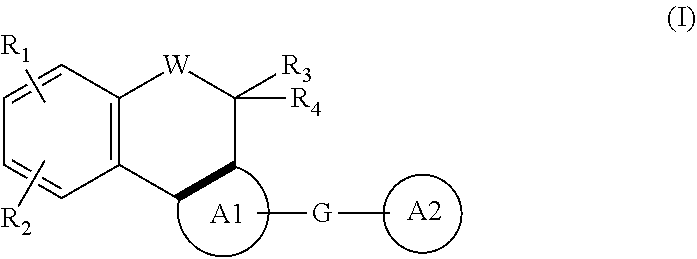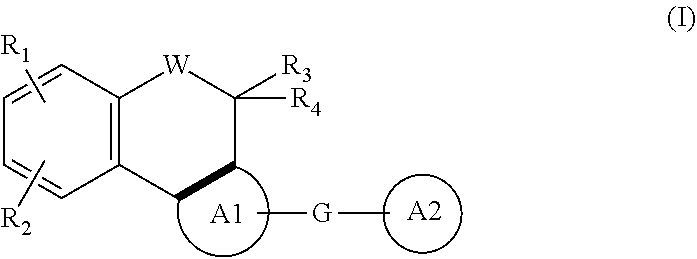Chromenopyridine derivatives as phosphatidylinositol phosphate kinase inhibitors
a technology of phosphatidylinositol and pyridine, which is applied in the direction of group 3/13 element organic compounds, drug compositions, organic chemistry, etc., can solve the problem of no known therapeutic agents which effectively inhibit the synthesis of pip5kii-beta, and achieve the effect of improving the efficacy and safety profil
- Summary
- Abstract
- Description
- Claims
- Application Information
AI Technical Summary
Benefits of technology
Problems solved by technology
Method used
Image
Examples
example 1
ate 1—Methyl 4-(6-chloro-4-formyl-3-pyridyl)-3-fluoro-benzoate
[0578]
[0579](2-Fluoro-4-methoxycarbonyl-phenyl)boronic acid (220 mg, 1.11 mmol), 5-bromo-2-chloro-pyridine-4-carbaldehyde (230 mg, 1.04 mmol), PdCl2(PPh3)2 (37 mg, 0.05 mmol) and K2CO3 (360 mg, 2.61 mmol) were taken up in MeCN (5 ml) and water (1 ml) and the resulting mixture was stirred at 70° C. for 1 h. When cooled to rt the mixture was concentrated and the resulting residue was diluted with water (3 ml) and extracted with EtOAc (2×5 ml). The combined organics were purified on a silica gel column eluted with 0-50% EtOAc in heptane to give the product as a gum (210 mg, 69%). MS ES+ m / z 294 [M+H]+.
example 2
ate 2—Methyl 4-[6-chloro-4-(1-hydroxyethyl)-3-pyridyl]-3-fluoro-benzoate
[0580]
[0581]3M MeMgCl in THF (286 μl, 0.86) was added dropwise to a solution of methyl 4-(6-chloro-4-formyl-3-pyridyl)-3-fluoro-benzoate (210 mg, 0.72 mmol) in THF (5 ml) at 0° C. under a nitrogen atmosphere and the resulting mixture was stirred at 0° C. for 1 h. Sat. aq. NH4Cl (2 ml) was added followed by water (2 ml) and EtOAc (5 ml). The organic layer was separated and the aqueous layer extracted with EtOAc (2×5 ml). The combined organics were washed with brine, dried over Na2SO4, filtered and concentrated to give the product as a gum (205 mg, 93%). MS ES+ m / z 310 [M+H]+.
example 3
ate 3—3-Chloro-N,N,5-trimethyl-5H-chromeno[4,3-c]pyridine-8-carboxamide
[0582]
[0583]NaH (60% in mineral oil, 51 mg, 1.32 mmol) was added to a solution of methyl 4-[6-chloro-4-(1-hydroxyethyl)-3-pyridyl]-3-fluoro-benzoate (205 mg, 0.66 mmol) in THF (5 ml) at 0° C. under a nitrogen atmosphere. The mixture was stirred at 0° C. for 30 min and then at rt overnight. More NaH (60% in mineral oil, 51 mg, 1.32 mmol) was added and the mixture was stirred at 40° C. for 3.5 h, followed by 50° C. for 4 h. The resulting mixture was cooled to rt. Water (3 ml) and EtOAc (4 ml) were added to the mixture. The aqueous layer was separated and the organic layer extracted with 1M aq. NaOH (1 ml). The aqueous layers were combined and pH adjusted to ˜3 using 2M aq. HCl. The formed precipitate was collected, washed with water and dried to give the product as a solid (3-chloro-5-methyl-5H-chromeno[4,3-c]pyridine-8-carboxylic acid). The solid was taken up in SOCl2 (2 ml, 27.4 mmol). A drop of DMF was added to ...
PUM
 Login to View More
Login to View More Abstract
Description
Claims
Application Information
 Login to View More
Login to View More - R&D
- Intellectual Property
- Life Sciences
- Materials
- Tech Scout
- Unparalleled Data Quality
- Higher Quality Content
- 60% Fewer Hallucinations
Browse by: Latest US Patents, China's latest patents, Technical Efficacy Thesaurus, Application Domain, Technology Topic, Popular Technical Reports.
© 2025 PatSnap. All rights reserved.Legal|Privacy policy|Modern Slavery Act Transparency Statement|Sitemap|About US| Contact US: help@patsnap.com



